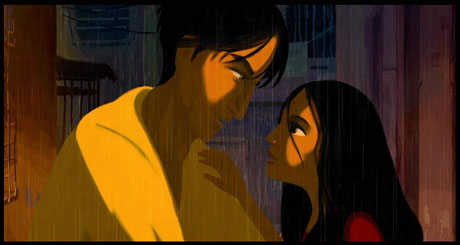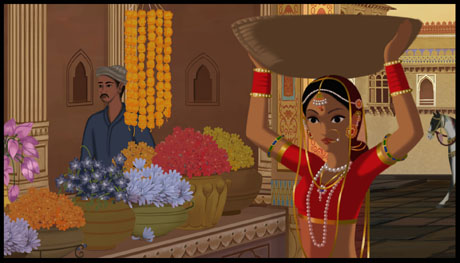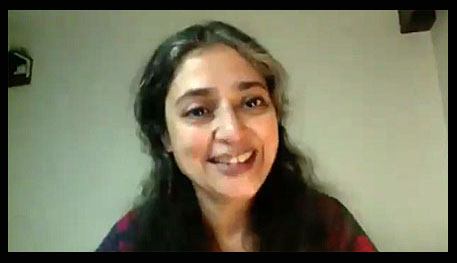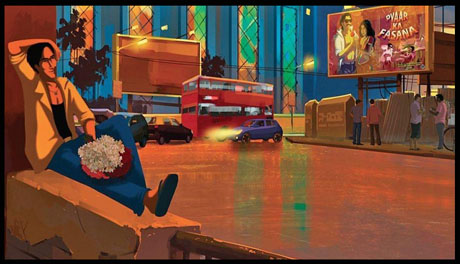
Like 2017’s Oscar nominated Loving Vincent, Bombay Rose is a completely painted animated feature. This new romantic drama from director Gitanjali Rao is now streaming on Netflix. Rao discusses the making of the movie and how it might impact Hollywood and Bollywood over the next several years.
Jackson Murphy: This is one of the most ambitious animated movies I’ve ever seen and one of the best of 2020. When did the idea of, “I want to make a fully painted animated film” come into your mind?
Gitanjali Rao: All the [animated] films that I’ve made have all been painted frame by frame. That’s the only thing I’ve ever wanted to do in my life. And yes, the jump from shorts to feature was a big, ambitious one. It probably happened after the success of my short Printed Rainbow. Immediately people were like, “So are you going to make a feature?” And I said, “No. I’m very happy making shorts.” And I kind of lost out on the momentum because I wasn’t ready. And people don’t understand: it’s not like live-action when doing the jump from shorts to a feature. In frame by frame painted animation, you need to think a lot. You need to sacrifice a lot. It’s a big jump. So somewhere around 2008/2009, I started developing ideas for features. I worked on three, and this is the only one that saw the light of day and was completed. The other two we started but we couldn’t finish because they were, as you said, too ambitious.

JM: Because of the success of this, would you be interested in going back to those other two films and finish them and revisit them again?
GR: No way! I want to make new ones! They’re done. They’re finished.
JM: (laughs)
GR: The fun is in developing a film and I kind of developed those two films. And they were perfect for the time at which I was making them. But now where I find myself and in terms of what people are watching, they will be new, fresh ideas.
JM: I love the fascination you have with movies and movie stars – the older woman looking back on her career and the new action movie star with his imperfections. What did you want to show with these two characters and the movie industry?
GR: It’s not me. It’s the people and the audience that I look at. They’re completely taken over by stars in India. Especially in a city like Bombay. It’s Bollywood. It’s so dictated by the stars of Bollywood. You all know it. And the song and dance. Really poor people actually sacrifice probably a week’s earnings to buy a ticket to go and watch the first show of a star, even in today’s time. So it’s a religion. I know it’s a religion for a lot of people. And I wanted to delve into that and get into the psyche of a fan – a person who’s a fan of a Bollywood star and how he or she actually lives their life.
JM: That’s interesting. I think older moviegoers these days still have feelings of nostalgia for “the stars”. But for younger people, I’m not so sure nowadays here in America because of stars being on TV shows that you can watch on your cellphones, I’m not sure that fascination with the movie star is still there. But clearly in India it still is.
GR: We change very slowly. Even our Prime Minister is a star. Idolizing is in our blood. Idolizing to the extent where you became an escapist… is our reality today. It’s great that the younger generation in the U.S. is getting out of it. But the younger generation in India is still probably a couple of generations backwards in terms of the culture and the adoration. In the technology, they’ve come in line with the American generation. But in idolizing: parents, politicians, stars… we love.

JM: My all-time favorite movie is the animated Beauty and the Beast. And at the center of that, obviously, is a rose. What interests you in – and fascinates you about – a rose and made you want to make it one of the focal points of the film?
GR: It’s a romantic symbolization. And then also the Jasmine in the rose. They have multiple layers. The Jasmine is from the Hindu culture and the rose has been brought in from the Mughal and Islam culture. It’s important in a tropical country like India. Both of them become symbols of love in two totally different cultures. The rose, I realized, is so universal because of the British and Mughals and coming down to us. It symbolizes so many different eras of being used as a symbol of love. So I wanted to use cliches. Bollywood is a cliche that I use. Rose is a cliche that I use. But I make it into a non-cliche.
JM: You’re right. You do it in a non-cliche way, especially with the screenplay and how you tie everything together. Was that one of your goals… to make sure everything connected together and make us think about the beginning at the end?
GR: Yeah. It’s exactly like when she leaves those flowers into a garden, that’s the principal I use for the entire film. Everything is woven together. Even love and love stories are woven together and that’s when they make a picture. So yeah, I kind of use that as a metaphor for the entire film. And I’m glad you caught it.
JM: Oh yeah. And there are some nice surprises. Take me through the timeline of the painted animation itself.
GR: We didn’t take very long in production. What actually took very long was finding the finance for the film, which took about four years. But the actual production was just 21 months: 18 months of animation and three months of post production with sound. It was quite a challenge because the style is very individual. It doesn’t follow conventions. When I animate, I paint every frame. But when we had to extend it to a studio… they came-up with this idea of dividing it into a bunch of senior animators who would draw to the line drawing in software and then give it all to a bunch of junior animators who would do the in-betweens and the shadow layers. And then it would be taken into Photoshop where we have a bunch of really junior artists painting every frame over two layers. The covering artists didn’t really know animation, but they didn’t need to. And the animators didn’t know how to paint, and they didn’t need to. We got three teams together to perform like one person. We had a small team of 20 to start with and we ended-up with about 80. But let me tell you: people in India work 14-16 hours and on Saturdays and Sundays. All the time.

Gitanjali Rao
JM: Wow. That’s amazing. And I really like that you use a lot of the transitions with cars and other vehicles to go from different shots or scenes within shots.
GR: I wanted the point of view of the entire film to be like you’re stuck in a traffic jam in Bombay and you’re watching life around you. And that happens to all of us all the time. That’s how I’ve discovered the city and understood the life in its underbelly. Hours stuck in a bus or a car and watching life passing by. These elements became a part of the film. I wanted to have something that keeps these two people away from each other. Metaphorically, the traffic… there’s a lot of it. It’s chaotic. If a person wants to cross… you really have to endanger your life and cross through that when you want to get to the other side without a signal. He’s doing that all the time to woo her. That… keeps the two of them away from each other. Two sides of the road. Two different religions. And if you use traffic, you can always wipe the scenes. I used it to my advantage. And I realize people sitting in the cinema get the feeling of being in a crowded, busy road if you do this quite a lot.
JM: I could even feel this watching it at home. The film had such a nice festival run last year and then Netflix came on board for distribution.
GR: We had been in talks with Netflix… as soon as the film was out in Venice. They [let it play at] Venice, Toronto [and others] to see how people were taking it. It was a festival favorite. Netflix was our first choice and they took it. It took a while for them to come on the position, which happens with Netflix. They watch a film and see how it works.

JM: I remember watching Loving Vincent three years ago… and being impressed by it as well. It got an Oscar nomination and major awards play because the animation community embraced it. How do you feel about that potential awards season for Bombay Rose?
GR: I’m not thinking about it at all. I know the surprises and disappointments and all that comes with it. I think it’s better to have a distance. It’s quite stressful. So I’m being zen right now and saying, “It’s okay if it happens. It’s okay if it doesn’t happen.” But awards are… I leave it to whatever will happen will happen. But my team is excited. This is a first for India. Everyone is getting more convinced that it’s a good film.
JM: I think (and hope) you will get some major nominations because you and the film deserve them. And what do you think this film will do for Indian Cinema and animation where you are?
GR: The film is not releasing in theaters. It’s going straight to Netflix. There isn’t much of an audience for animation films in India that are not for children or a pure entertainer. We are spoiled on Disney/Pixar and DreamWorks. It’s a fact – even with the language and the culture, the kids love it. So we have not had European or Japanese animation. Nothing apart from American, Hollywood animation coming into the theaters in India. So in that scenario, to have one Indian film try to reach its neck out is a tough thing. But what I think is nice is: some important nominations, then people are going to sit up and look at it.
In a pandemic year, I think one can’t wish for anything better than this. A lot more people are sitting and watching Netflix now than I would’ve had as an audience going into the theaters and watching it. So it’s nice.
- INTERVIEW: “Inside Out 2” Director And Producer On Pixar Sequel - April 16, 2024
- INTERVIEW: “Puffin Rock And The New Friends” And 25 Years Of Cartoon Saloon - April 10, 2024
- INTERVIEW: “Chicken For Linda!” Directors On Annecy Winning Feature - April 9, 2024


 March 8th, 2021
March 8th, 2021  Jackson Murphy
Jackson Murphy  Posted in
Posted in  Tags:
Tags: 






